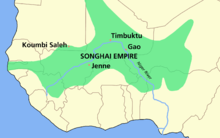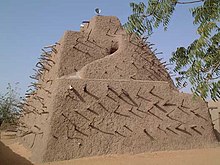Askia Mohammad I.
Askia Mohammad I (born around 1443 as Muhammad Ture or Mohamed Toure in Fouta Toro , later known as Askia ; died 1538 ), also known as Askia the Great and Mamar Kassey, was the ruler, military commander and political reformer of the Songhairian Empire in the late 15th century. He was the descendant of Sunni Ali Ber . Under Askia Muhammad his country strengthened and formed the largest empire in the history of West Africa . During the height of Askia's rule, the Songha Empire comprised the countries of the house states , Kano (now Nigeria ) and a large part of the territories that previously belonged to the Songha Empire in the west. His policy was followed by a massive increase in trade with Europe and Asia , the establishment of many schools and the establishment of Islam as an integral part of the empire.
Domination

After Sunni Ali passed away, Sunni Baru , his son and intended successor , refused to call themselves a Muslim. This refusal prompted one of Sunni Ali's generals to challenge the succession. General Ture defeated Baru and ascended the throne in 1493.
General Ture, later known as Askia Mohammad I or Askia the Great, then initiated an expansion and consolidation program that extended the empire from Taghaza in the north to the borders of Yatenga in the south and from Aïr in the northeast to Fouta Djallon in Guinea . Through his merits, the Songhai Empire experienced an unprecedented cultural heyday and the entire country flourished as a center for research and trade.
Instead of shaping the empire according to Islamic standards, he showed sensitivity and further developed the traditional model through a bureaucratic system of government that is unique in West Africa. In addition, Askia established trade regulations and standardized guidelines, began to monitor trade routes and created an organized tax system.
He was overthrown by his son Askia Mūsā in 1528.
legacy
Askia promoted education and literature and made sure that Mali's universities trained the most respected scholars. Many wrote important books and manuscripts, one of them was his friend and nephew Mahmud Kati. To legitimize the overthrow of the Sonni dynasty, he allied himself with the scholars of Timbuktu and ushered in a golden age for science and Islamic teachings in the city. For example, the eminent scholar Ahmed Baba wrote books on Islamic laws that are still in use today. Muhammad Kati published Tarik al-Fattah and Abdul-Rahman as-Sadi wrote Tarik ul-Sudan ("Chronicles of Africa"), two history books that are indispensable for today's researchers for the reconstruction of medieval African history.
Askia was buried in the tomb of Askia in Gao , a World Heritage Site .
Individual evidence
- ^ Josef W. Meri: Medieval Islamic Civilization: LZ, index. Taylor & Francis, 2006, ISBN 978-0-415-96692-4 , p. 764 ( limited preview in Google book search).
- ↑ a b Biographical information on historical African figures from globaled.org
- ↑ Askia the Great from blackhistorypages.net ( Memento of the original from May 23, 2007 in the Internet Archive ) Info: The archive link was inserted automatically and has not yet been checked. Please check the original and archive link according to the instructions and then remove this notice.
- ↑ http://global.bridica.com/EBchecked/topic/396293/Muhammad-I-Askia#md-media-strip-tab-lists-content
- ^ Vogel, Joseph O., Encyclopedia of Precolonial Africa: Archeology, History, Languages, Cultures, and Environments , page 493 (1997). ISBN 0-7619-8902-1
Web links
| personal data | |
|---|---|
| SURNAME | Askia Mohammad I. |
| ALTERNATIVE NAMES | Mohamed Toure; Muḥammad Ibn-Abī-Bakr I. |
| BRIEF DESCRIPTION | Ruler of the Songha Empire |
| DATE OF BIRTH | around 1443 |
| DATE OF DEATH | 1538 |
